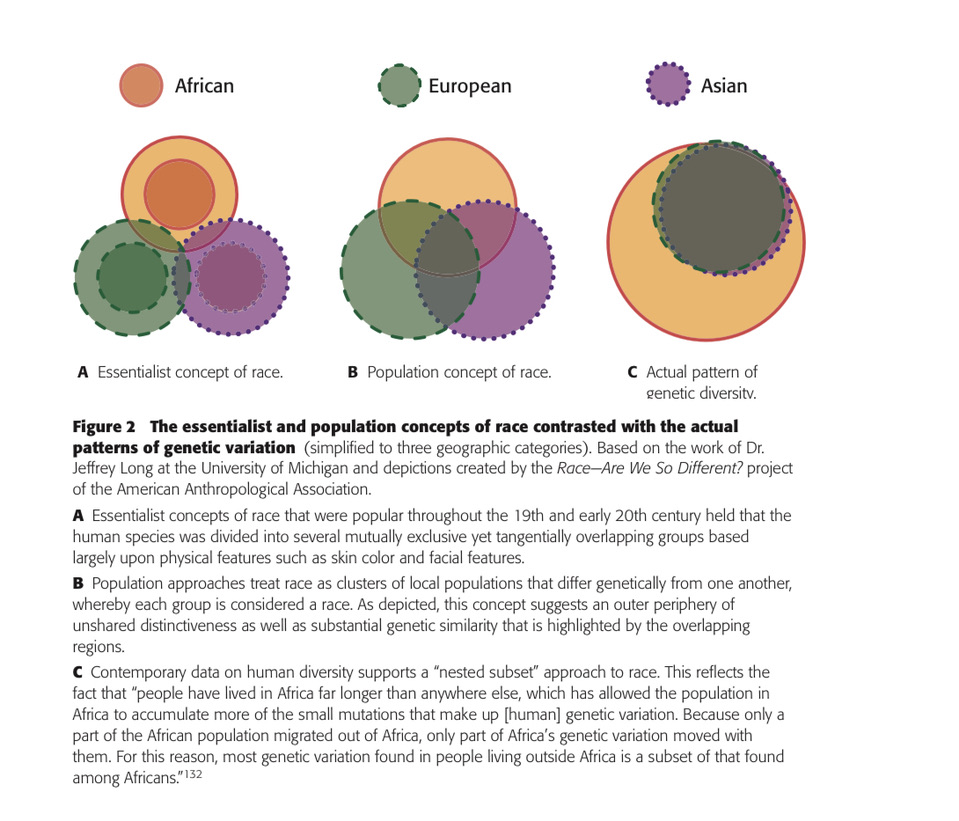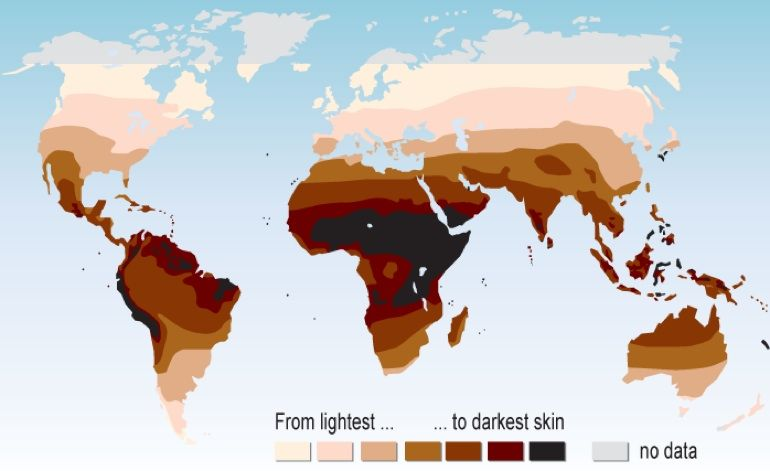mNo edit summary Tag: Visual edit |
(Map) Tag: Visual edit |
||
| (6 intermediate revisions by 3 users not shown) | |||
| Line 1: | Line 1: | ||
'''Race''' is a [[social construct]] which influences how people are treated and viewed by society based on their skin color and | [[File:Race diagram.png|thumb|There is much more genetic variation within [[Africa|African]] populations that between Africans and [[White people|whites]]]] | ||
[[File:Skin color map.png|thumb|Map of skin colors around the world. Indigenous people from [[Hellenic Republic|Greece]], eastern [[People's Republic of China|China]], southern [[Commonwealth of Australia|Australia]], and much of the [[United States of America|United States]] all have similar skin colors despite being considered different races.]] | |||
'''Race''' is a [[social construct]] which influences how people are treated and viewed by society based on their skin color, appearance, and other traits. Although the term is used as a generic word to describe perceived differences between members of society from varying ethnic backgrounds, it is a scientifically inaccurate category related to phenotypical differences which have minimal influence on human behavior.<ref>{{Citation|title-url=https://blogs.scientificamerican.com/observations/the-concept-of-race-is-a-lie/|title=The Concept of “Race” Is a Lie|author=By Peter G. Prontzos|date=May 14, 2019}}</ref> Discrimination of people based on racial differences is called [[racism]]. | |||
The concept of race | The concept of race has been used since the 16th century to justify the invasion and [[Colonialism|colonization]] of lands, the [[genocide]] and [[slavery]] of peoples and the brutality associated with [[capitalism]], [[liberalism]] and [[primitive accumulation of capital]]. [[Karl Marx]] wrote that the racial divide was a major obstacle for the workers' movement and that, "[[Proletariat|Labour]] cannot emancipate itself in the white skin where in the black it is branded."<ref>{{Citation|author=[[Karl Marx]]|year=1867|title=Capital, vol. 1|chapter=The Working-Day|chapter-url=https://www.marxists.org/archive/marx/works/1867-c1/ch10.htm|quote=In the [[United States of America|United States of North America]], every independent movement of the [[workers]] was paralysed so long as [[slavery]] disfigured a part of the Republic. Labour cannot emancipate itself in the white skin where in the black it is branded.|mia=https://www.marxists.org/archive/marx/works/1867-c1/index.htm}}</ref> | ||
== History == | |||
The concept of race first began in [[Monarchy of Spain (1516–1700)|Spain]] with the expulsion of [[Judaism|Jews]] and [[Islam|Muslims]] from the Iberian Peninsula and allowed the Spanish monarchy to continue oppressing them even after some converted to [[Christianity]]. In the early 17th century, the [[Kingdom of England (927–1707)|English]] defined the Irish as racially inferior while [[Settler colonialism|colonizing]] northern Ireland.<ref name=":8">{{Citation|author=[[Roxanne Dunbar-Ortiz]]|year=2014|title=An Indigenous Peoples' History of the United States|title-url=|chapter=Culture of Conquest|page=36–9|pdf=https://www.lcps.org/cms/lib/VA01000195/Centricity/Domain/10601/An%20Indigenous%20Peoples%20History%20of%20the%20United%20States%20Ortiz.pdf|city=Boston|publisher=Beacon Press Books|series=ReVisioning American History}}</ref> | |||
During the colonization of [[Americas|America]], whiteness emerged as a form of [[class collaboration]] against [[Indigenous peoples of the Americas|indigenous peoples]]. The first use of "white" in an official document was in [[Commonwealth of Virginia|Virginia]] in 1691.<ref>{{Web citation|author=[[Eugene Puryear]]|newspaper=[[Liberation School]]|title=The U.S. state and the U.S. revolution|date=2022-07-10|url=https://www.liberationschool.org/the-u-s-state-and-the-u-s-revolution/|archive-url=https://web.archive.org/web/20230604173435/https://www.liberationschool.org/the-u-s-state-and-the-u-s-revolution/|archive-date=2023-06-04}}</ref> A labor movement of [[Slavery|slaves]] and [[Indentured servitude|indentured servants]] emerged in the 17th century, but the labor movement largely excluded non-white workers, enslaved or not, by the 1830s.<ref name=":0">{{Web citation|author=Bill Fletcher Jr.|newspaper=[[Monthly Review]]|title=Race Is About More Than Discrimination|date=2020-07-01|url=https://monthlyreview.org/2020/07/01/race-is-about-more-than-discrimination/|archive-url=https://web.archive.org/web/20230323205358/https://monthlyreview.org/2020/07/01/race-is-about-more-than-discrimination/|archive-date=2023-03-23}}</ref> Many white workers and [[Peasantry|peasants]] such as [[John Brown]] and [[Newton Knight]] soon turned against their [[Bourgeoisie|ruling class]].<ref>{{Web citation|author=Paul Wilcox|newspaper=[[Liberation School]]|title=Abolitionist solidarity — Black and white — in the struggle against slavery|date=2020-09-07|url=https://www.liberationschool.org/abolitionist-solidarity-in-the-struggle-against-slavery/|archive-url=https://web.archive.org/web/20230610064324/https://www.liberationschool.org/abolitionist-solidarity-in-the-struggle-against-slavery/|archive-date=2023-06-10}}</ref> | |||
Around the time of the [[Statesian Civil War|Civil War in the United States]], most [[Trade union|trade unions]] in the [[United States of America|USA]] accepted [[Kingdom of Italy (1861–1946)|Italians]] and [[Republic of Ireland|Irish]] workers but rejected [[Qing dynasty (1636–1912)|Chinese]] immigrants. The [[Industrial Workers of the World|IWW]] became the first union to include workers regardless of race.<ref name=":0" /> | |||
== References == | == References == | ||
Latest revision as of 19:55, 25 November 2023


Race is a social construct which influences how people are treated and viewed by society based on their skin color, appearance, and other traits. Although the term is used as a generic word to describe perceived differences between members of society from varying ethnic backgrounds, it is a scientifically inaccurate category related to phenotypical differences which have minimal influence on human behavior.[1] Discrimination of people based on racial differences is called racism.
The concept of race has been used since the 16th century to justify the invasion and colonization of lands, the genocide and slavery of peoples and the brutality associated with capitalism, liberalism and primitive accumulation of capital. Karl Marx wrote that the racial divide was a major obstacle for the workers' movement and that, "Labour cannot emancipate itself in the white skin where in the black it is branded."[2]
History
The concept of race first began in Spain with the expulsion of Jews and Muslims from the Iberian Peninsula and allowed the Spanish monarchy to continue oppressing them even after some converted to Christianity. In the early 17th century, the English defined the Irish as racially inferior while colonizing northern Ireland.[3]
During the colonization of America, whiteness emerged as a form of class collaboration against indigenous peoples. The first use of "white" in an official document was in Virginia in 1691.[4] A labor movement of slaves and indentured servants emerged in the 17th century, but the labor movement largely excluded non-white workers, enslaved or not, by the 1830s.[5] Many white workers and peasants such as John Brown and Newton Knight soon turned against their ruling class.[6]
Around the time of the Civil War in the United States, most trade unions in the USA accepted Italians and Irish workers but rejected Chinese immigrants. The IWW became the first union to include workers regardless of race.[5]
References
- ↑ By Peter G. Prontzos (May 14, 2019). The Concept of “Race” Is a Lie.
- ↑ “In the United States of North America, every independent movement of the workers was paralysed so long as slavery disfigured a part of the Republic. Labour cannot emancipate itself in the white skin where in the black it is branded.”
Karl Marx (1867). Capital, vol. 1: 'The Working-Day'. [MIA] - ↑ Roxanne Dunbar-Ortiz (2014). An Indigenous Peoples' History of the United States: 'Culture of Conquest' (pp. 36–9). ReVisioning American History. [PDF] Boston: Beacon Press Books.
- ↑ Eugene Puryear (2022-07-10). "The U.S. state and the U.S. revolution" Liberation School. Archived from the original on 2023-06-04.
- ↑ 5.0 5.1 Bill Fletcher Jr. (2020-07-01). "Race Is About More Than Discrimination" Monthly Review. Archived from the original on 2023-03-23.
- ↑ Paul Wilcox (2020-09-07). "Abolitionist solidarity — Black and white — in the struggle against slavery" Liberation School. Archived from the original on 2023-06-10.